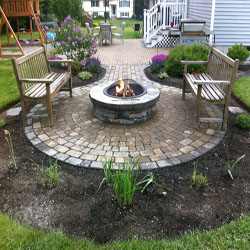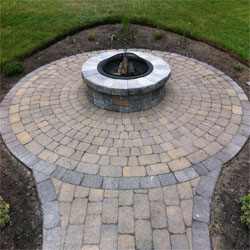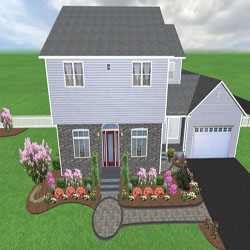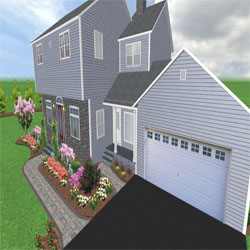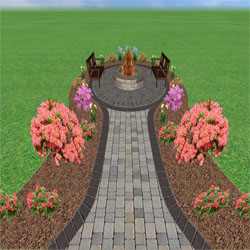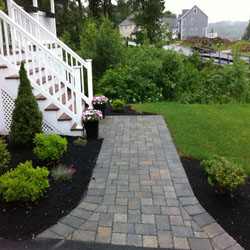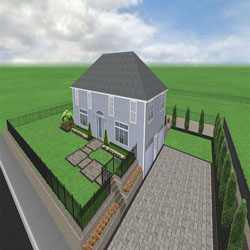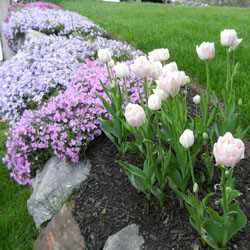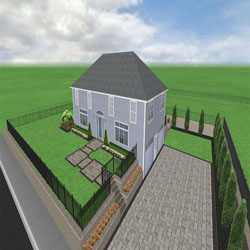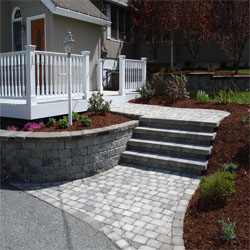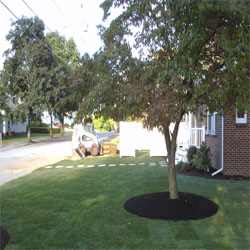Landscape Lighting | Commercial Landscape Lighting
Landscape Lighting adds beauty , safety, and security to your home or business. Lighting will highlight your home’s architectural features. Landscape lighting lets you take advantage of your outdoor spaces at night, and adds security to this space.
There are many different designs we can do with landscape lighting. We have uplighting, downlighting, moonlighting, and shadowing. We also have many different fixtures we can use too. You can light up your house, walkways, and planting beds. You can also use underwater lights for your pond. There are lights for your hardscapes as well. The lights that we use are all LED lights, which means they are low cost and energy efficient.
When it comes to lighting, seeing is believing. Customers can’t visualize the final product simply by looking at fixtures, and it’s difficult to explain it to them. That’s why Tompkins offers free overnight demonstrations to prospective, prequalified customers. Once you are qualified, we will set up the lights and will leave them on the property for up to a week so that you can get a good feel for the quality and improvement outdoor landscape lighting will add to your property. In addition to aesthetic improvement, there are studies that have shown that outdoor lighting cuts down on crime.
Whether it is to brighten your property for beauty or safety, landscape lighting is a worthwhile investment. Landscape lighting is visual – it’s dramatic and it accentuates part of the landscape and the house. It enhances architecture, lights up dark areas and draws attention to specific trees or plant beds. It extends the ability to utilize your landscaped areas into the evening hours. People spend thousands on their landscaping, and if they don’t have lighting they can’t enjoy it after the sun goes down.
Customers want lighting, but not a high price tag. Tompkins can design anything from higher end systems to more reasonable mid-range systems using a variety of products. People can choose to purchase off-the-shelf material for less money, but it does not work anywhere like a properly designed and installed system by trained installers.
Our landscape lighting work is of the highest quality in materials and workmanship. We use a quality check list to make sure things are done properly on every job. Before any work is started on your property, we will construct a diagram and perform a walkthrough with the customer to demonstrate the placement of fixtures.
Throughout the job, a foreman will inspect all connections ensuring proper fitting and a correctly installed and working product for years to come. Once finished, everything is inspected again to be certain everything in the work area is neat and clean in appearance before doing a walk-around with the customer. Although it’s low voltage, we are working with electricity and we want to make sure that everything is absolutely perfect and in even better condition than when the job was started.
On average, charges anywhere from $150 to $250 per fixture, depending on job size, difficulty, labor and fixture type. Many competitors exhibit a tendency to charge a flat price, like $150 per fixture. Per-fixture to square-footage comparison pricing cannot be done for pavers, because there are too many variables on each job, including walkways, driveways, existing trees or other landscape features. All our installed systems are fully expandable to allow for future expansion or changes in the property designs over the years.
There are a multitude of benefits to having lighting professionally installed. While it involves an investment, the finished product is more serviceable, more durable and lasts longer. Most customers are all too familiar with the lower quality lighting available at retail stores and can anticipate that it is going to fail with in the year. It does not last, the bulbs always burn out, so why waste your time and money trying to do it yourself?
It is essential to be mindful when designing / installing a variety of lighting to avoid "black holes," or dark, neglected spaces. Popular items we install are a wall wash light, which spews a burst of light rather than a beam. This type is best to backlight or directly light an area, but is not ideal for tall trees. As with any fixture installation, you need to determine the beam spread for what you’re using – the width of the beam you’re throwing out. A mini spotlight will accent the peak of a house or a far distance. But if you light up a shrub with a mini spot, you will end up with a spot of light on the shrubbery. If you have something close to the light you need to use a large spot that puts out a wide beam.
TECHNICAL TIPS.
Wiring and wattage trip up many contractors during lighting installation. "The hardest part is designing your wire run so that you avoid a voltage drop," Running more than 100 watts through 100 feet of wire can cause power problems. "Try to limit your wattage and your distance between your wire runs, and use multiple runs if you can. Also, make sure that you add up your wattage and don’t exceed the capacity of the transformer."
- Check for proper voltage – Use the proper formula (voltage drop = amps x distance x 2 x resistance per foot). Use Ohm’s Law (amps = watts/volts) to determine amps. The resistance per foot for #12-2 wires is 0.00162.Check your amperage on all secondary wire runs – Limit your secondary runs to 16 amps.
- Check your amperage on the primary side (transformer) – Use an amp meter to ensure that you haven’t overloaded the transformer.
- Use smart wiring techniques – Use efficient wiring methods such as the Hub or Loop System to get equal voltage to lamps.
- Use long lasting lamps – Halogen and Xelogen lamps provide the longest life available (between 4,000 to 10,000 hours).
- Date the back of your lamps – This tracks bulb life and provides proof of installation.
- Use lithium-based grease on connections – This stops corrosion from oxidation and rust.
- Size your transformer for expansion – Allow room on the transformer to add fixtures.
- Document your voltage and amperage – Write the voltage and amperage of secondary wire runs on the inside door of the transformer.
Category- Commercial Landscape Lighting



